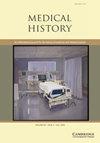病理学先驱和女性榜样:犹太科学家Rahel Rodler, Ruth Silberberg, Lotte Strauss和Zelma Wessely
IF 1.1
2区 哲学
Q4 HEALTH CARE SCIENCES & SERVICES
引用次数: 0
摘要
迄今为止,女医生在纳粹受害者的科学研究中扮演了次要角色;这也适用于病理学专家。在此背景下,本研究考察了杰出的犹太病理学家Rahel Rodler(1878-1944)、Ruth Silberberg(1906-97)、Lotte Strauss(1913-85)和Zelma Wessely(1914-2004)的传记。重点是她们作为女科学家的作用及其在纳粹上台后的命运性职业,并结合她们在当时的医学研究和医学专业以及病理学学科中的地位。这项研究主要基于来自德国、奥地利和瑞士各州和大学档案馆、英国国家档案馆和华盛顿特区国家档案和记录管理局的档案资料。结果表明:(1)这4名女性病理学家在当代病理科学界是罕见的例外,数量份额不到5%。他们在两个层面(性别和“种族”)受到歧视。(3)由于专业上的卓越和持续的奉献,四位女病理学家中的三位得以逃离纳粹德国,并在移民中取得了非凡的事业。由此可以得出结论,Rodler、Silberberg、Strauss和Wessely是当代病理学的女性榜样和先驱科学家。本文章由计算机程序翻译,如有差异,请以英文原文为准。
Pioneers in pathology and female role models: the Jewish scientists Rahel Rodler, Ruth Silberberg, Lotte Strauss and Zelma Wessely
Abstract So far, female physicians have played a minor role in scientific studies of Nazi victims; this also applies to specialists in pathology. Against this background, the present study examines the biographies of the outstanding Jewish pathologists Rahel Rodler (1878–1944), Ruth Silberberg (1906–97), Lotte Strauss (1913–85) and Zelma Wessely (1914–2004). The focus is on their roles as women scientists and their fateful careers after the Nazi rise to power, embedded in the context of the position of women in medical studies and the medical profession of their time as well as in the subject of pathology. The study is primarily based on archival sources from various German, Austrian and Swiss state and university archives, from the British National Archives and from the National Archives and Records Administration in Washington DC. The paper provides three key findings: (1) The four female pathologists were rare exceptions in the contemporary pathological scientific community with a quantitative share of less than 5%. (2) They experienced discrimination on two levels (gender and ‘race’). (3) Thanks to professional excellence and continued dedication, three of the four female pathologists were able to escape from Nazi Germany and achieve remarkable careers in emigration. It can be concluded that Rodler, Silberberg, Strauss and Wessely rose to female role models and pioneer scientists in contemporary pathology.
求助全文
通过发布文献求助,成功后即可免费获取论文全文。
去求助
来源期刊

Medical History
医学-科学史与科学哲学
CiteScore
1.60
自引率
0.00%
发文量
25
审稿时长
>12 weeks
期刊介绍:
Medical History is a refereed journal devoted to all aspects of the history of medicine and health, with the goal of broadening and deepening the understanding of the field, in the widest sense, by historical studies of the highest quality. It is also the journal of the European Association for the History of Medicine and Health. The membership of the Editorial Board, which includes senior members of the EAHMH, reflects the commitment to the finest international standards in refereeing of submitted papers and the reviewing of books. The journal publishes in English, but welcomes submissions from scholars for whom English is not a first language; language and copy-editing assistance will be provided wherever possible.
 求助内容:
求助内容: 应助结果提醒方式:
应助结果提醒方式:


